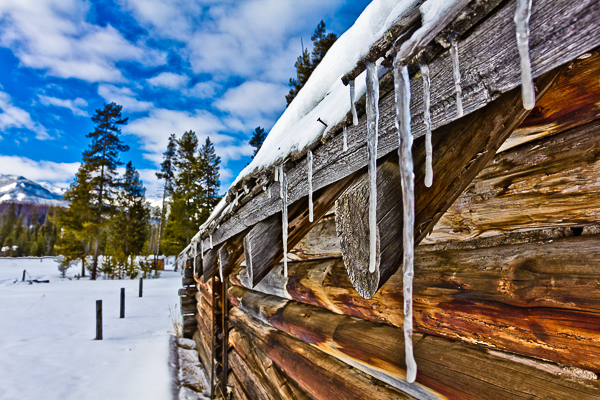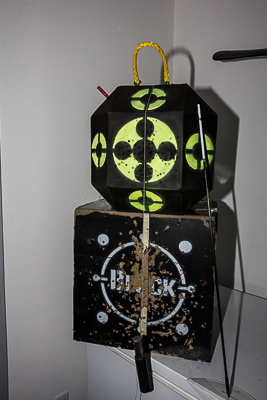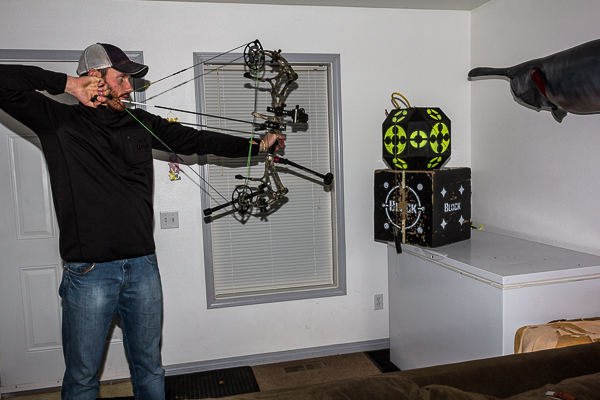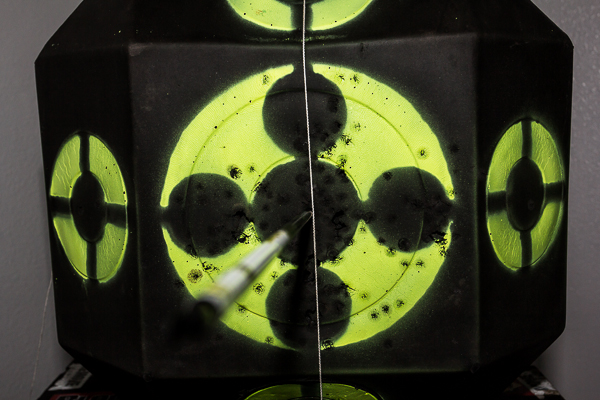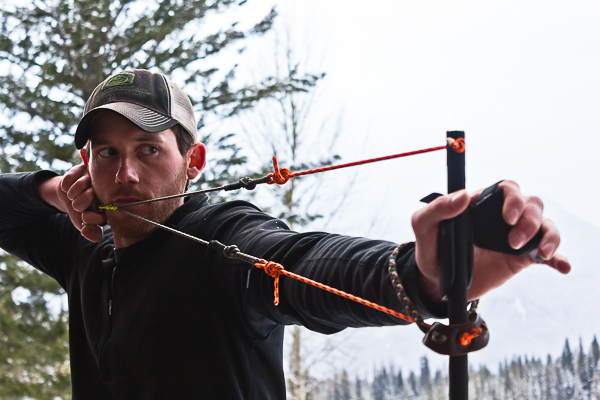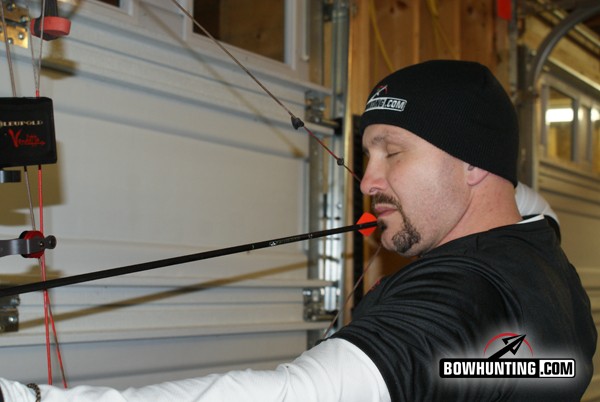LAST UPDATED: May 1st, 2015
With winter upon us, now is the time to refine our skills for the upcoming hunting season. It seems that each year we all get busier in our daily lives, yet ideally we all need to strive to make time to continue advancing our bowhunting knowledge and honing our shooting skills. Both of which will only make us deadlier bowhunters.
Your backyard or shooting range might now look like this. Even with a blanket of snow on the ground, winter is the perfect opportunity to refine your shooting skills
After a fall of bowhunting, I hear of a lot of people deciding to hang up their bows for the winter, since spring hunting seasons are more than six months away and big game seasons a full eight to nine months away. People may think that they can resume practice again next summer and start back where they left off last year…but hear me out…unfortunately that is far from the truth. Bowhunting is all about getting that one chance to take a shot so why not continue to shoot your bow throughout the winter and further refine those skills?
Why Shoot In The Winter?
With today’s bow technology, it is easy to assume that since your bow is so much more forgiving than in years past that you can pick it up six months later and continue to shoot arrows perfectly. Keep in mind that bow accuracy doesn’t come easily; it is something that is refined over time and is the result of hard work. Don’t let yourself get into a slump and put that bow away. Here is a prime example of why I feel bowhunters should continue to practice throughout the winter.
Winter shooting requires just a few items to improve your shooting and keeps muscles strong and in check
It has long been understood that if you’re lifting weights for quite a few months and all of a sudden decide to take a break from weight lifting, it won’t be long until you notice a decrease in strength. When you start lifting again you will not be able to pick up where you left off, strength-wise. The same thing happens in regards to shooting your bow. All of that accuracy and muscle memory that you gained last season shooting your bow is slowly going to decrease over time once you stop shooting. For me as a bowhunter I know that shot opportunities are limited. Knowing this, I do everything I can in my shooting regimen to prepare myself for these rare shot opportunities throughout the year. Winter practice is undoubtedly the most important practice of the entire year. It is a time to reassess how you shoot a bow and work on areas that need refinement.
How To Shoot In Winter
Winter months normally bring cold temperatures and lots of snow for those of us living in the northern states, so practicing outdoors can be very difficult. That being said, I feel that longer range practice may not truly help enhance your shooting during the winter months. Your time is most likely better spent utilizing short range shooting in your garage, basement, “man cave”, or even a local archery shop. This is where you will begin to reach a new level of shooting performance.
Practicing at close range with a bare shaft will help you work on form and quickly exposes any and all shooting flaws that exist
The best winter practice I have found is at a distance of 6-9 feet from the target and eventually working out to 10 yards. The majority of the time I will shoot only bare shafts in the winter. Bare shafts create a level of difficulty in the practice, since they need to be shot perfectly out of the bow for them to fly straight. The bow needs to be tuned correctly for bare shafts and your form must be PERFECT! You will soon notice applying a little more hand pressure or torqueing your wrist during the release will throw the bare shaft off. Shooting bare shafts will test your patience and will magnify form flaws, which is why I feel these winter practice sessions are so important. These long winter months enable you to create muscle memory and develop a stable platform for your form. With time you are able to create a solid bow hand form that reduces torque. You will notice the effect that hand torque will have on your shot while shooting bare shafts at longer and longer distances.
Next Level Practice
To make practice sessions more difficult I take a length of string (most of the time I use serving material, but any small diameter string that is visible against the target will work), attach it to the top of the target, and tie a weight at the end of the string, similar to a plumb bob, enabling the string to lie in a straight line down from the target and serve as your aiming reference. I feel the string is a better aiming reference than a dot since this is such a short shooting distance. The goal here is to split the string or hit the string and make it move out of the way. Caution should be used when using this technique to avoid hitting your arrows; I try to keep it to three arrows at a time and space them out along the target. All of this promotes better bow hand form and perfect shot execution over time. As you master shooting at extremely close distances with a bare shaft, slowly work your way further back and repeat the process again, trying to break the string.
As you move further away from the target while shooting a bare shaft, having perfect shot execution as well as form will prove to be even more crucial to hit the string
Alternate Methods
Another way I practice in the winter is by utilizing a laser on my bow while holding the dot from the laser as steady as possible while at full draw and at the same time holding my bow back as long as possible. This will quickly develop muscle memory and will also serve as practice for those times when you’re stuck at full draw waiting for an animal to move into position for a shot.
I do this by first attaching a laser pointer on the vertical bar of my sight and position it so that it points in the same direction as that I will be looking when at full draw through my peep and pin. The laser allows me to see my perceived movement at full draw. I will then either utilize my smart phone’s timer function or just watch a clock on the wall and record the amount of time I can effectively hold the bow back at full draw and still execute a clean release. The key word here is “effectively.” Only you will know what effective means in terms of holding the bow back steadily enough for a shot.
Another option for working on shot execution is to build yourself a training device. Link: https://www.bowhunting.com/blog/2013/2/12/building-a-back-tension-training-device/
With practice you will surprise yourself with how much longer you can hold your bow back while keeping the pin steady without starting to shake. Eliminating pin movement is nearly impossible, but you can reduce the amount of pin movement with practice which will help you greatly in the field. There are also tools on the market that utilize lasers that you can purchase to try to steady your aim. They work very well, or you can always build your own device with a little time and creativity. I feel utilizing lasers are a great tool for the bowhunter, as you can easily see the amount of movement.
Blank It For Success
Another way I practice in the winter is through blank baling. There is no better time to blank bale than during the slower winter months. Blank baling is simply shooting at a blank target with your eyes closed or other times with your eyes open at very close range. You are not focused on hitting a spot on the target, rather the purpose of this is to develop a proper shot execution and work on developing correct form. Blank baling must be performed with a purpose and you must be fully engaged in what you are doing. You cannot shoot at the target without a purpose. Focus on working on one aspect of your shooting at a time such as bow hand form until perfected and then switch to shot execution, for example. The key is to keep it simple and maximize your practice sessions.
Blank bail shooting may seem weird at first, but it will ultimately teach you to “feel” the shot and provide vital muscle memory
While these methods might seem foreign to most bowhunters, these techniques are all great practice methods that work wonders in the winter, as well as all times of the year. Now after reading all of this you may be asking yourself if all this is worth it, or that I must have all the time in the world to develop my archery game. The truth is I am just like everyone else out there. I have commitments that I must take care of each day, a job to attend, and family to be around. You can make yourself a better archer by taking 15-30 minutes each night or just a few times a week. I feel we all can easily devote more time to practice sessions. All it takes is a few minutes less of TV or a few minutes less of social media to open up free time for practice sessions. Shooting in the winter is great exercise and keeps you in tune. Keep shooting those arrows, develop a winter practice routine, and most importantly have fun!

